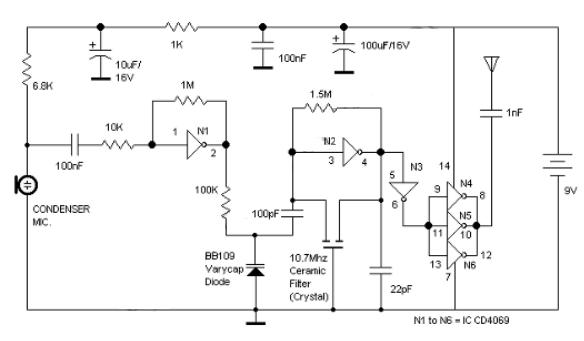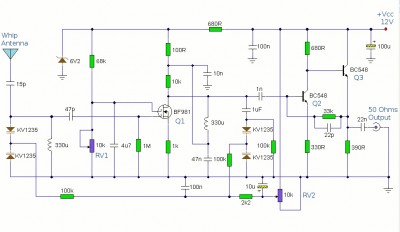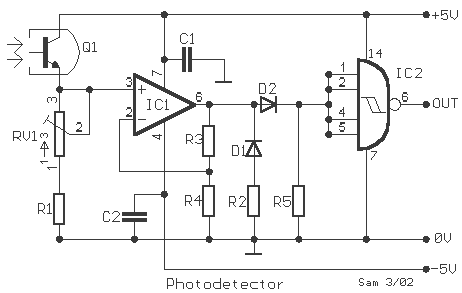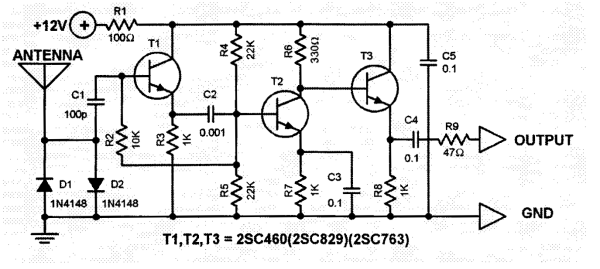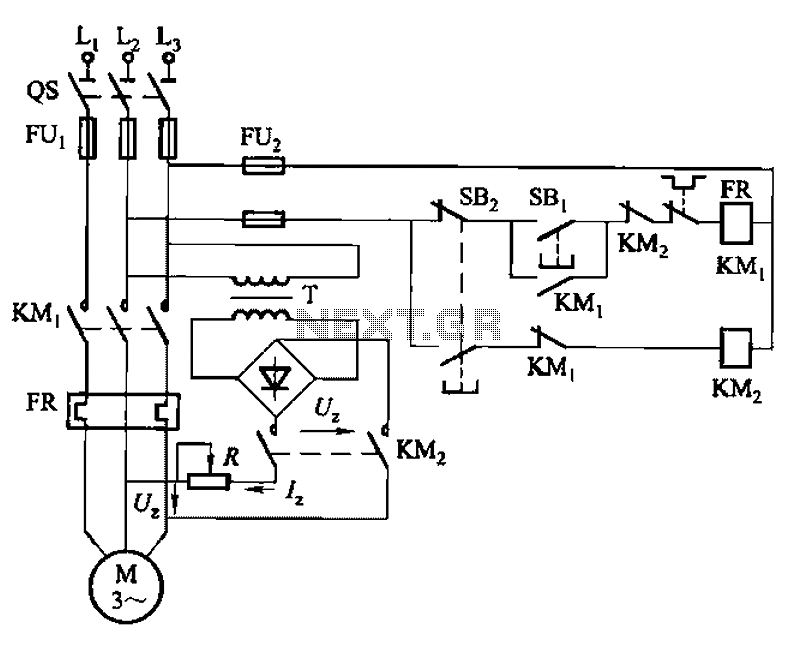
Circuit example of the LM381

National Semiconductor (NS Company) produces audio integrated circuits (ICs) that offer wide frequency response and low noise. These circuits provide excellent performance across all NS products. The circuit illustrated in Figure 3-12 includes a preamplifier and a singing equalizer utilizing the LM381, along with dynamic noise reduction achieved through the LM1894. The LM381 serves as a DC volume control and features a wide-band, high-gain, low-noise amplifier circuit designed for small signal amplification. It incorporates a specialized dual front amplifying circuit characterized by low noise levels when the signal source resistance (Rs) is 600 ohms, with frequencies ranging from 10 Hz to 10 kHz, resulting in an equivalent input noise voltage of 0.5 microvolts. The LM381 is widely utilized in various measuring devices, small signal amplifiers, and broadband signal source circuits in practical applications. An external bias adjustment allows for optimal noise characteristics, making it a broadband, high-gain, low-noise, high-quality amplifier. The application circuit for the LM381 is depicted in Figure 3-14, with its internal circuitry and pin arrangement shown in Figure 3-13. The internal structure of the LM381 consists of two separate pre-amplifier inputs with 60 dB isolation between them, along with an internal power source decoupling circuit that provides a power supply rejection ratio of 120 dB. The IC boasts a very high voltage gain of 100 dB, a large output voltage swing, and a significant signal bandwidth (small signal bandwidth of 15 MHz and large signal bandwidth of 75 kHz). It operates under a wide power supply voltage range of 9V to 15V and includes short circuit protection and internal compensation. The electrical characteristics are detailed in Table 3-2. One half of the LM381 IC2 serves as a phono equalizer amplifier, while the other half (IC1) functions as an input amplifier for line, CD player, and magnetic tape playback, with the capability to switch inputs via SA1. The LM1894 dynamic noise reduction circuit processes the output signal from the noise after 4.11 feet (for left and right channels). An output select switch (SA2) allows for the selection of noise access circuits, and a potentiometer of 1 kΩ is provided to adjust the noise reduction sensitivity. The LM1035 dual-channel DC volume control potentiometer is connected at its output to a loudness volume control potentiometer and switch J.
The audio circuit described integrates several key components that work together to enhance audio quality and performance. The LM381, as the central element, is designed for high fidelity and low noise operation, making it suitable for professional audio applications. The dual preamplifier configuration allows for effective isolation between channels, minimizing crosstalk and improving overall sound clarity. The incorporation of a dynamic noise reduction circuit through the LM1894 further enhances the listening experience by reducing unwanted background noise, which is particularly beneficial in environments with high ambient noise levels.
The versatility of the LM381 is evident in its ability to operate across a range of supply voltages, ensuring compatibility with various power sources while maintaining performance integrity. The significant voltage gain and output swing capabilities enable it to drive subsequent stages in audio amplification systems effectively. Additionally, the inclusion of short circuit protection and internal compensation mechanisms ensures reliability and stability during operation, safeguarding the circuit against potential damage.
In practical applications, the circuit can be configured to accommodate different audio sources, including vinyl records, CDs, and magnetic tapes, providing flexibility for users. The ability to adjust noise reduction sensitivity via a potentiometer allows for personalized tuning based on the specific audio environment, further enhancing the user experience.
Overall, this audio IC design exemplifies the integration of advanced technologies in audio processing, providing a comprehensive solution for high-quality sound reproduction in various applications. The detailed specifications and configurations outlined facilitate a deeper understanding of the circuit's capabilities and potential uses in the field of audio engineering.National Semiconductor (NS Company) production of audio ICs wide frequency response, low noise, assembled with its audio circuits, very good performance in all NS o The company integrated circuit shown in Figure 3-12. Enter Pre and sing equalizer to use LM381, dynamic noise reduction using the LM1894, LM10350 LM381 DC volume control using a wide -band, high-gain, low noise amplifier circuit, which is designed for small signal amplification design of special Dual front amplifying circuit. Its low noise, when the signal source resistance Rs = 600fl, frequency IOHz ~ lOkHz, equivalent noise input Valid values 0,5r.eVo LM381 in a variety of measuring devices, small signal amplifiers and various broadband signals source circuit is widely used o in practical applications, an external bias adjustment, enable it to achieve the best noise characteristics become broadband, high gain, low noise, high-quality amplifiers.
Shown, LM381 application circuit shown in Figure 3-14 its internal circuitry and pin arrangement shown in Figure 3-13. Internal LM381 consists of two separate pre-amplifier input, 60dB isolation between each other and with internal power source decoupling circuit and has 120dB power supply rejection very high voltage gain ( lOOdB) ratio o LM381, large output voltage swing and a large signal bandwidth (small signal bandwidth 15MH, large signal bandwidth 75kH).
9V ~ 15V it can work under a wide power supply voltage, and short circuit protection and internal compensation has finished Bodhisattva. Electrical characteristics as shown in Table 3-2. That is half of the LM381 IC2 composition phono equalizer amplifier, and the other half that is composed of IC1 line, CD player, a magnetic tape playback input amplifier, can switch SAi by selecting them individually to the input.
LM1894 dynamic noise reduction circuit, the output signal from the noise after 4,11 feet (left and right channel) o Output Select switch for selecting noise SAz whether access circuit 05 feet have connected the potentiometer for 1kfl adjust the noise reduction sensitivity O LM1035 dual-channel DC volume control potentiometer, at its output end that loudness volume control potentiometer and switch J.
The audio circuit described integrates several key components that work together to enhance audio quality and performance. The LM381, as the central element, is designed for high fidelity and low noise operation, making it suitable for professional audio applications. The dual preamplifier configuration allows for effective isolation between channels, minimizing crosstalk and improving overall sound clarity. The incorporation of a dynamic noise reduction circuit through the LM1894 further enhances the listening experience by reducing unwanted background noise, which is particularly beneficial in environments with high ambient noise levels.
The versatility of the LM381 is evident in its ability to operate across a range of supply voltages, ensuring compatibility with various power sources while maintaining performance integrity. The significant voltage gain and output swing capabilities enable it to drive subsequent stages in audio amplification systems effectively. Additionally, the inclusion of short circuit protection and internal compensation mechanisms ensures reliability and stability during operation, safeguarding the circuit against potential damage.
In practical applications, the circuit can be configured to accommodate different audio sources, including vinyl records, CDs, and magnetic tapes, providing flexibility for users. The ability to adjust noise reduction sensitivity via a potentiometer allows for personalized tuning based on the specific audio environment, further enhancing the user experience.
Overall, this audio IC design exemplifies the integration of advanced technologies in audio processing, providing a comprehensive solution for high-quality sound reproduction in various applications. The detailed specifications and configurations outlined facilitate a deeper understanding of the circuit's capabilities and potential uses in the field of audio engineering.National Semiconductor (NS Company) production of audio ICs wide frequency response, low noise, assembled with its audio circuits, very good performance in all NS o The company integrated circuit shown in Figure 3-12. Enter Pre and sing equalizer to use LM381, dynamic noise reduction using the LM1894, LM10350 LM381 DC volume control using a wide -band, high-gain, low noise amplifier circuit, which is designed for small signal amplification design of special Dual front amplifying circuit. Its low noise, when the signal source resistance Rs = 600fl, frequency IOHz ~ lOkHz, equivalent noise input Valid values 0,5r.eVo LM381 in a variety of measuring devices, small signal amplifiers and various broadband signals source circuit is widely used o in practical applications, an external bias adjustment, enable it to achieve the best noise characteristics become broadband, high gain, low noise, high-quality amplifiers.
Shown, LM381 application circuit shown in Figure 3-14 its internal circuitry and pin arrangement shown in Figure 3-13. Internal LM381 consists of two separate pre-amplifier input, 60dB isolation between each other and with internal power source decoupling circuit and has 120dB power supply rejection very high voltage gain ( lOOdB) ratio o LM381, large output voltage swing and a large signal bandwidth (small signal bandwidth 15MH, large signal bandwidth 75kH).
9V ~ 15V it can work under a wide power supply voltage, and short circuit protection and internal compensation has finished Bodhisattva. Electrical characteristics as shown in Table 3-2. That is half of the LM381 IC2 composition phono equalizer amplifier, and the other half that is composed of IC1 line, CD player, a magnetic tape playback input amplifier, can switch SAi by selecting them individually to the input.
LM1894 dynamic noise reduction circuit, the output signal from the noise after 4,11 feet (left and right channel) o Output Select switch for selecting noise SAz whether access circuit 05 feet have connected the potentiometer for 1kfl adjust the noise reduction sensitivity O LM1035 dual-channel DC volume control potentiometer, at its output end that loudness volume control potentiometer and switch J.

